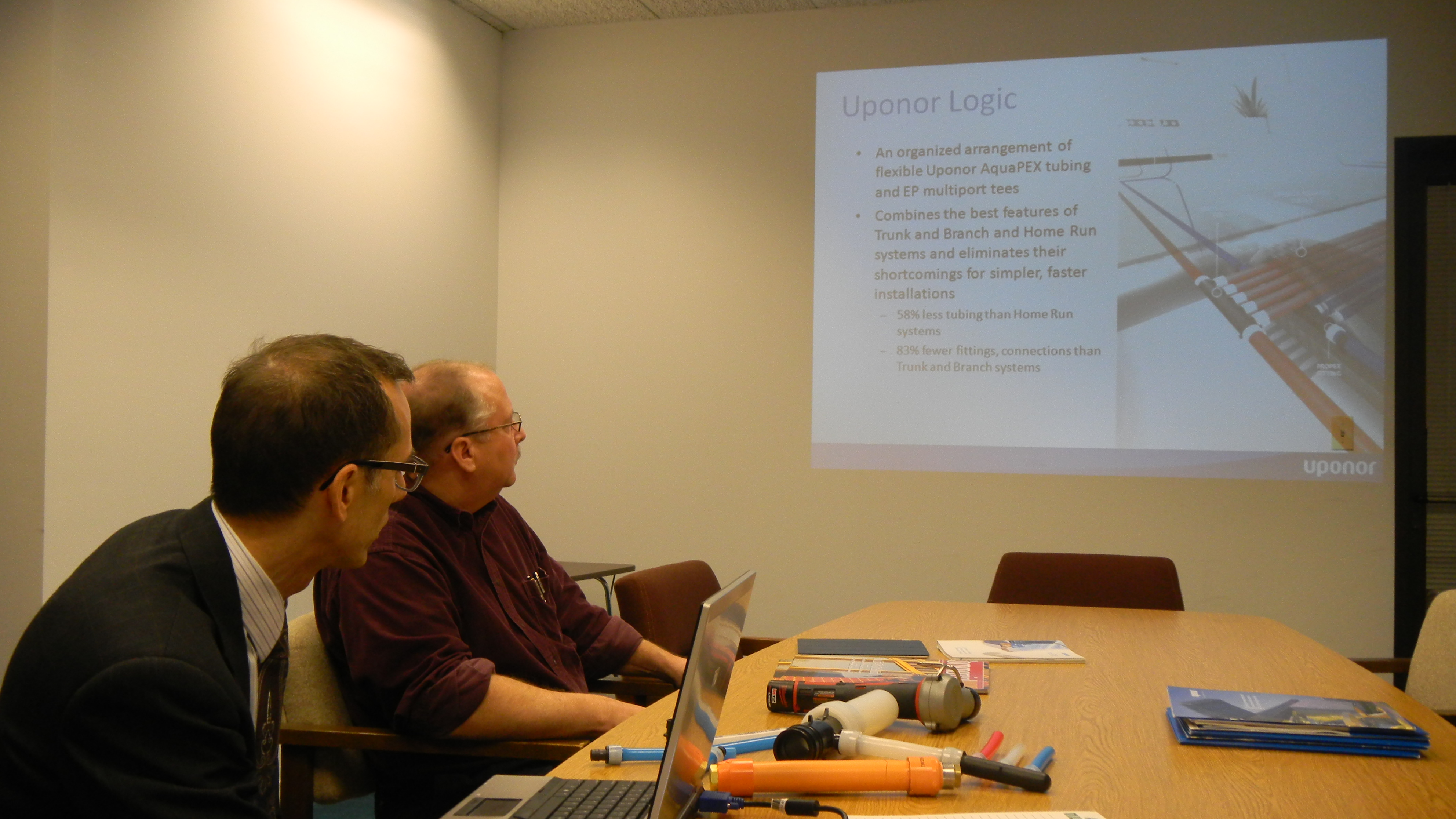Posts Tagged ‘public relations’
- Jan
- 6
Posted on January 6, 2012 by John OReilly
This entry is Part 2 of our look at the fundamentals of staging effective media tours. View Part 1 here. Below is a slideshow of images from a recent media tour for Uponor in Chicago.
Fundamental #2: Have something to show. Visual aids are a must and typically take the form of a PowerPoint presentation. I can hear you suppressing a yawn, but a slide show has solid practical value in holding the editors’ attention, while making what you say more concrete and therefore more memorable—especially if your slide show is part of your leave-behind. (More on that in a bit.)
In creating the PowerPoint or whatever tools you prefer, don’t shortchange the visual imagery. The editors may not read along as you move from slide to slide. But strong pictorial elements, especially of product components, cutaways, schematics, graphs, tables, flow charts and the like will help make your words resonate. And your audience won’t fail to appreciate the care you have taken in crafting your presentation.
The only communications aid better than an image or an illustration is the thing itself. If possible, bring actual products or components, so that the editors can see and touch that special new finish or unique functionality first-hand. The hands-on approach will generate more interest, more questions and more enthusiasm for whatever you are presenting.
On my most recent media tour, the client highlighted his company’s proprietary method for making pipe connections, which can seem a rather mundane affair when left solely to verbal descriptions. Step-by-step graphics are better, but how about actually making a connection right there in front of the editors? That’s what my client did, and his rather quick and simple demo made a solidly positive impression on each group of editors. When one asked to do a connection himself, it was easily one of the highlights of that session. What better way to persuade an editor of the value of your product or system?
Fundamental #3: Have something to leave behind. While building relationships is the primary benefit of a media tour, clients understandably expect a more tangible payoff in the form of actual publicity. The surest way to make that happen is to create a press kit dedicated solely to the meeting or media tour. Also, be sure to bring enough copies so that all attendees can have one if they wish.
This kit should contain press materials relating to your presentation, including news releases and photography of new and recently introduced products. But you might also want to include relevant case studies, white papers, product brochures, as well as your PowerPoint presentation and a corporate backgrounder that the editors can keep on file for future reference. Anything that adds to their understanding of your company and its mission is of potential interest.
That may sound like information overload, which is why I strongly recommend making the kit electronic: Editors will accept paper kits, but they love the easy portability and “file-ability” of a disc and, best of all, a flash drive. Do not miss this opportunity to impress the press. The fastest way to an editor’s heart—and to the pages of his or her publication—is to make the job of using your materials easier.
Fundamental #4: Find converging interests. Generating more publicity for the brand is at the top of the wish lists of most marketers, regardless of the state of the economy or the market. Meanwhile, editors find themselves constantly scrambling for information and ideas to meet the relentless content requirements of their proliferating communications outlets, print and online.
One of the best ways to discover where exactly your mutual interests converge is through a face-to-face dialogue with the editors. Trade shows and other venues offer numerous occasions for such meetings, but except for a tour of your own factory, none matches the effectiveness of a “deskside” get-together for building relationships and identifying ways to meet editor interests and needs.
- Jan
- 5
Posted on January 5, 2012 by John OReilly
Recently, I completed one of my favorite activities as a public relations professional: a three-day “media tour,” in which I accompanied one of our manufacturer-clients in a series of face-to-face meetings with the editor staffs of roughly a dozen trade magazines at their Chicago-area offices.
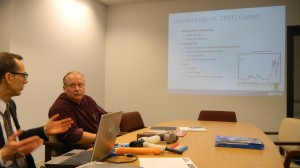 As a former trade-pub editor myself, I enjoy connecting with my old colleagues on their home turf in a relaxed and friendly setting. (Meeting with trade and consumer media in other major publishing centers for our building and architectural products field, such as New York, Washington and Des Moines, is a lot of fun, too.)
As a former trade-pub editor myself, I enjoy connecting with my old colleagues on their home turf in a relaxed and friendly setting. (Meeting with trade and consumer media in other major publishing centers for our building and architectural products field, such as New York, Washington and Des Moines, is a lot of fun, too.)
But the true beneficiaries—and properly so—are our clients and the editors themselves, who use these occasions to gain a better understanding of one another’s interests and needs on their way to forging deeper and more productive relationships.
Each media-tour meeting, which typically runs sixty to ninety minutes, merits its own approach, depending on the editor, the client and the season. But there are certain fundamentals for any get-together that will ensure success both during the meeting and in its aftermath. Pay close attention to these basics and, when all is said and done, you’ll have zero doubts about the value of the experience.
Fundamental #1: Have something to say. It’s not enough to just show up and plop down for a little coffee and chit-chat: This isn’t a chance encounter at a trade show. Editors are routinely cordial to their guests, but they will expect the meeting to have a specific intent, enabling them to learn things they don’t already know. Without a worthwhile agenda, you’ll likely have a hard time even getting on their schedules.
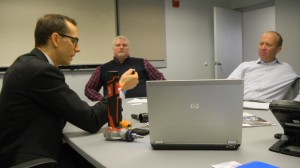 Previewing a new product is a great way to anchor a media tour: An editor’s main mission is to report on “what’s new,” so your audience will welcome an in-depth look at your latest offering. This approach is also a great way to generate a quick and tangible payoff on your meeting in the form of coverage of your new product in an upcoming issue.
Previewing a new product is a great way to anchor a media tour: An editor’s main mission is to report on “what’s new,” so your audience will welcome an in-depth look at your latest offering. This approach is also a great way to generate a quick and tangible payoff on your meeting in the form of coverage of your new product in an upcoming issue.
But editors are also on the prowl for content that is more general and not-so-brand-centric in scope. They need “big ideas” they can readily translate into feature stories, in line with their published editorial calendars.
So, in addition to announcing your newest product and what makes it so special, put all those messages in the context of the industry zeitgeist: Why this particular product at this particular time for this particular audience? What needs does it meet? How does it fit in with the general direction of the market? How does it differ from what came before?
What’s more, those questions need not be confined to a new product. Editors will generally welcome your POV on the overall industry (or at least your product category): where it’s been, where it’s headed and why, and how you are adjusting your strategies in response.
This type of big-picture presentation will deliver compelling ideas around which editors can build their own trends stories. And when they finally get around to writing such a story, guess whom they are most likely to contact for further insights and information?
Check back tomorrow for three more fundamental elements of a successful media tour, as well as a gallery of images from a recent tour for Uponor.
- May
- 19
Posted on May 19, 2011 by Erik Hoffer
So said panelists on the media breakfast hosted by BusinessWire in Chicago last week.
Featured guest speakers included Kathryn Janicek, Daypart Manager/Executive Producer, NBC 5 Chicago; Susanna Negovan, Editor-in-Chief, Michigan Avenue Magazine; and Kathryn Born, founder and Editor-in-Chief of both TINC Magazine (Technology Industry News – Chicago) and Chicago Art Magazine.
Here are several interesting points the speakers made during the event, some of which reinforced OR/DP’s view on media relations and some of which seem to be new concepts due to ever-evolving social media outlets:
- Don’t bother leaving voicemails with media. Due to meetings and appointments throughout the day, they may only have three hours at their desk and have no interest in fielding voicemails. It was noted that some media contacts have interns check voicemails once a week at best.
- One speaker estimated that she fielded only 20% of e-mail pitches. So how do you create the one in five that gets opened? Be creative with the subject line without burying the lead for the content that is being pitched. Keep e-mail pitches to one paragraph (without attachments) if possible. When pitching by phone, don’t bother introducing yourself. Just get straight to the point of the pitch as you would with an e-mail.
- Relating to the brevity of pitches, more media contacts are accepting them via social media such as Twitter and Facebook. NBC’s Janicek even welcomed receiving creative pitches via cell phone text messages (if one is lucky enough to get her number).
- Take the time to review a publication’s content and tie it into your pitches if possible. Media contacts appreciate someone who knows their publication, news program, etc. and takes time to do the research.
- Mar
- 25
Posted on March 25, 2011 by Nora DePalma
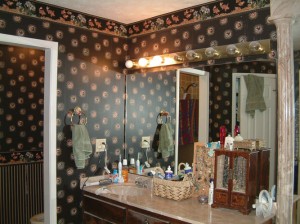
The "ugly bathroom" David Sturm of Attention to Detail Remodeling had to work with.
Three talented remodeling professionals were recently recognized for transforming some of the ugliest bathrooms in the country into beautiful showpieces as part of an online contest sponsored by American Standard Brands.
The contest, called “America’s Ugliest Bathrooms: Solved”, was hosted by remodeling industry journalist Leah Thayer on her popular and informative website, daily5Remodel.com. Winners received the brand new 5-Function Shower System from American Standard as well as another unique and particularly valuable prize: special public relations assistance to help them promote their win, compliments of American Standard.
The three winning projects included:
- Fort Lauderdale, Fla.-based remodeler Tamara J. Dalton of Tamara Dalton Design Studios, who tackled a mold-infested bathroom outfitted with cheap tile and cabinets, and a drab beige tub deck. Dalton enlarged the shower and installed a low-flow toilet, beautiful porcelain and glass mosaic tiles, and granite countertops to complete the beautiful new design.
- Trent Ketchum, of Swansea, Ill.-based Fulford Home Remodeling, whose renovation job entailed gutting a tiny bathroom covered in outdated yellow wall tiles, and utilizing an adjacent seating area to create an expansive and beautiful room with a new clawfoot tub, walk-in shower, and vanity seating area with storage.
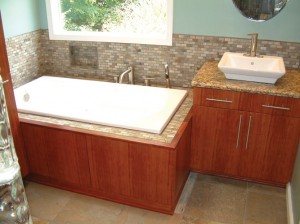
A shot of the now attractive and light-filled bathroom after Attention to Detail finished the remodeling job.
- Roswell, Ga.-based David Sturm of Attention to Detail Home Remodeling, who transformed an uninviting, windowless bathroom covered in dark wallpaper and wood trim by adding a six-foot window, non-splash countertop sinks, a glassblock shower, and slate flooring to create an attractive new master bath.
We at OR/DP also must give a shoutout to Sturm and his David’s Dynamic Meatloaf recipe. Check it out here at Attention to Detail.
For more information about the contest and to view a complete set of “before & after” photos, see the complete press release.
- Feb
- 23
Posted on February 23, 2011 by Nora DePalma
The Problem With Public Relations - NYTimes.com: we read stories like this one on the NY Times small business blog and we don’t know whether to laugh or cry.
We laugh because we know we can do so much better at public relations. We cry because we don’t get the chance after good companies have been burned by bad PR.
How to avoid this?
1. Established PR firms know what it takes to get the job done. Once you’ve met and established objectives, your agency should be able to set success metrics. And not fluffy ones, either. You should be working against hard numbers: how many impressions does the agency estimate based on the scope of work? How many leads are expected? How many trade show interviews will there be? How many people will attend your event? You should agree in advance on the success metrics and receive regular reports on progress.
2. Check references, ideally from clients who have a similar business model or business challenges. Building products companies need PR firms with a strong track record in durable goods that have complex stories, long-selling cycles and varied sales channels. As this article shows, people are not shy about sharing a bad experience. Luckily, we also know that people aren’t shy about sharing a good experience.
3. Avoid onerous contracts. Don’t sign anything that holds you hostage to an agency. For a project-based relationship, you should be able to move on at any time. For an ongoing relationship, you should be able to break free in 30-45 days, depending on the volume of work and the length of relationship.
What are your tips to avoid bad PR happening to good companies?
